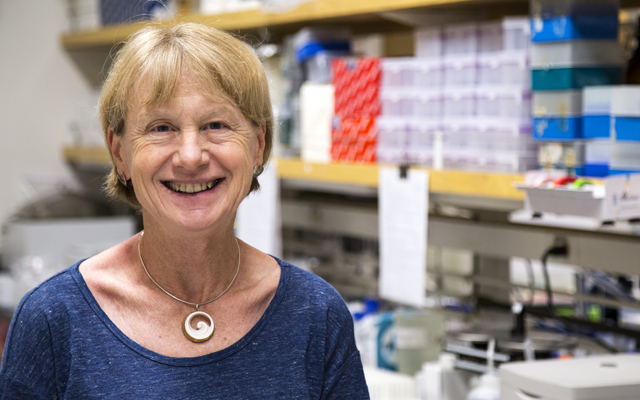UCSD: Kawasaki disease (KD) is the most common acquired heart disease in
children. Untreated, roughly one-quarter of children with KD develop
coronary artery aneurysms — balloon-like bulges of heart vessels — that
may ultimately result in heart attacks, congestive heart failure or
sudden death. The causative agent for KD remains unknown — a windborne pathogen is
suspected — but equally mysterious is why and how some children are more
susceptible. Researchers at University of California San Diego School
of Medicine, with colleagues at Rady Children’s Institute for Genomic
Medicine and in London and Singapore, have conducted novel whole genome
sequencing of a family in which two of four children were affected by
KD. They have identified plausible gene variants that predispose some
children to developing the disease. The findings were recently published in the PLOS ONE.
“This is the first successful analysis of whole genome sequence from a
family that revealed a new gene implicated in KD susceptibility,” said
senior author Jane C. Burns, MD, professor and director of the Kawasaki
Disease Research Center at UC San Diego School of Medicine and Rady
Children’s Hospital-San Diego. “The finding is intriguing because this
gene, a member of the Toll-like receptor family, encodes for a protein
that is expressed on the cell surface and uniquely binds to proteins
outside the cell that come from fungi. This may be a clue that fungal
antigens could be one environmental trigger for the disease.”
Prevalence rates of KD are increasing among children in Asia, the
United States and Western Europe. In Japan, the country with the highest
incidence: 306 out of every 100,000 children under the age of five,
with more than 14,000 new cases annually. One in every 60 boys and one
in every 75 girls in Japan will develop KD during childhood.
Incidence rates in the United States are lower — 9 to 19 per 100,000
children under age 5 — but rising, at least in San Diego County.
Predictive models estimate that by 2030, 1 in every 1,600 American
adults will have been affected by the disease.
KD has a clear genetic link. It is most common in the U.S. among
persons of Asian or African descent, but its genetics is complex and
researchers have struggled to identify which gene variants and
combinations cause some children to develop the disease. Burns and
colleagues employed analysis of whole genome sequence for the first time
to examine a six-member African-American family in which two children
had KD, but the parents and other siblings did not.
“Despite their apparent increased susceptibility, children of
African-American descent have been excluded from previous KD genetic
analysis,” the authors wrote.
Key among the tools used was whole genome sequencing, a process in
which the complete DNA sequence of a person’s genome is determined at a
single time. The researchers also looked at genome-wide association
studies, which search for genetic variation in large populations. The
goal was to find, if possible, distinct gene variants that, in
combination, might indicate predisposition to and higher likelihood of
developing KD.
The researchers identified a variation of the toll-like receptor 6
gene, which plays a fundamental role in the immune system, that may be
linked to the pro-inflammatory state during the acute stage of KD.
Previous research had not identified this gene as influencing
susceptibility to KD.
In addition, another variant in a gene called tumor-associated
calcium signal transducer 2, which is involved in cellular calcium
signaling, was highlighted. The authors said further investigation of
TACSTD2 is needed.
Burns said the study, with its analytic approach and use of whole
genome sequencing, represents a new method for uncovering relevant gene
variants in families affected by not just KD, but many other complex
genetic diseases.
“The analysis of whole genome sequence to understand disease genetics
is only recently becoming a tool that is affordable and manageable due
to new developments in computer science. We are excited to be learning
how to harness the power of this analysis to study our children,” Burns
said.
“Our next approach will be to compare the whole genome sequence from
KD patients with severe heart damage to those with no damage despite no
or delayed treatment. We hope this will lead us to the genetic pathways
that result in damage to the coronary arteries, which in turn will
suggest new therapies to target those pathways.”
Co-authors include: Jihoon Kim, Chisato Shimizu, Eric Levy, Andre M.
Ribeiro do Santos, Hai Yang, Olivier Harismendy, and Lucila
Ohno-Machado, UC San Diego; Stephen F. Kingsmore, and Narayanan
Veeraraghavan, Rady Children’s Institute for Genomic Medicine; Jay
Flatley, Illumina; Long Truong Hoang, Genome Institute of Singapore;
Martin L. Hibberd, London School of Hygiene and Tropical Medicine; and
Adriana H. Tremoulet, UC San Diego and Rady Children’s Hospital-San
Diego.
Funding for this research came, in part, from the National Institutes
of Health (U54HL108460) and the Gordon and Marilyn Macklin Foundation.
